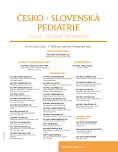Ethical concerns involving the newborns at risk
Authors:
B. Zlatohlávková
Authors‘ workplace:
Ústav humanitních studií v lékařství, UK 1. LF, Praha
přednosta doc. ThDr. V. Ventura, Th. D.
; Novorozenecké oddělení Gynekologicko–porodnické kliniky, VFN a UK 1. LF, Praha
primář prof. MUDr. R. Plavka, CSc.
Published in:
Čes-slov Pediat 2014; 69 (5): 319-327.
Category:
Ethics
Overview
In most cases ethical decision-making regarding neonates who require intensive care can be based upon the four primary bioethical principles – beneficence, nonmaleficence, respect for autonomy and justice. Because a newborn lacks such autonomy in the sense of freedom of choice decisions are made by the infant’s surrogates (most often parents) according to the best interests standard. In most cases parents and physicians come to a mutual agreement that does not jeopardize the interests of the child; only exceptionally in urgent situations it is possible or necessary to overcome the authority of the parents. Decisions in cases of chronically ill newborns and infants with congenital defects are not made in situations of emergency and an integral part of these decisions is the evaluation of the possible future quality of life. Decision-making about offering intensive care at the threshold of viability between 22–25 weeks of gestation cannot be entirely based upon existing principles and rules. These decisions are made in uncertainty. We are unable to predict with certainty the viability of an unborn child. We cannot forecast the consequences of our decision, nevertheless, we must decide. We have an objective medical uncertainty based upon insufficient knowledge and the lack of strong evidence regarding correct management. Out of this objective medical uncertainty comes subjective moral uncertainty. Even when we try to specify and balance the four bioethical principles we cannot reach a satisfactory solution. The source of our deepest uncertainty is the absence of a basic rule by which we could justify whether or not to initiate intensive care. The most righteous approach is to decide upon each child as a unique living being albeit the risk that we would have acted differently had we known the result beforehand. A decision made in uncertainty cannot be decided according a fixed standard of care because it would not withstand basic ethical requirements.
Key words:
ethical decission-making, principles of biomedical ethics, newborn, viability, intensive care, uncertainty Z.
Sources
1. Beauchamp TL, Childress JF. Principles of Biomedical Ethics. 5th ed. New York: Oxford University Press, 2001: 1–454.
2. Úmluva o lidských právech a biomedicíně č. 96/2001 Sb. mezinár. smluv. [cit. 2013 5-1]. Dostupné z: <http://www.clk.cz/oldweb/zakpred/Uml096-2001_EtikaBiomed.html>.
3. Zlatohlávková B. Komunikace a etika v neonatologii. In: Ptáček R, Bartůněk P a kol. Etika a komunikace v medicíně. Praha: Grada Publishing, 2011: 157–170.
4. Leuthner SR. Decisions regarding resuscitation of the extremely pramature infant and models of best interest. J Perinatol 2001; 21: 193–198.
5. Ladd RE, Mercurio MR. Deciding for neonates: Whose authority, whose interests? Semin Perinatol 2003; 27: 488–494.
6. Dikema DS. Parental refusal of medical treatment: the harm principle as threshold for state intervention. Theor Med Bioeth 2004; 25: 243–264.
7. Kopelmann LM. The best-interests standard as threshold, ideal, and standard of reasonableness. J Med Philos 1997; 22: 271–289.
8. Lantos JD, Meadow WL. Neonatal Bioethics. The Moral Challenges of Medical Innovation. Baltimore: The Johns Hopkins University Press, 2006: 1–171.
9. The International Liason Committee on Resuscitation (ILCOR) consensus on science with treatment recommendations for pediatric and neonatal patients: Neonatal resuscitation. Pediatrics 2006; 117: e978–e988.
10. Dokument Zachraňte Edwardse. [cit. 2013-6-30]. Dostupné z: <http://juliankas.blog.cz/rubrika/dokument-zachrante-edwardse>.
11. Blackmon LR. Biologic limits of viability: implications for clinical decision-making. NeoReviews 2003; 4: e140–e146. [cit. 2010-3-23]. Dostupné z: <http://neoreviews.aappublications.org>.
12. Zlatohlávková B. Viabilita plodu a novorozence. Actual Gyn 2011; 3: 47–51.
13. Pignotti MS, Donzelli G. Perinatal care at the threshold of viability: an international comparison of practical guidelines for treatment of extremely preterm births. Pediatrics 2008; 121: e191–e198.
14. Lagercrantz H. The emergence of the mind – a borderline of human viability? Acta Paediatr 2007; 96: 327–328.
15. Haumont D. Management of the neonate at the limits of viability. BJOG 2005; 112 (Suppl 1): 64–66.
16. Blanco F, Suresh G, Howard D, Soll FS. Ensuring accurate knowledge of prematurity outcomes for prenatal counseling. Pediatrics 2005; 115: e478–e487.
17. Hájek Z. Prenatální péče u komplikací a závažných patologických stavů v graviditě. Mod Gyn Por 1999; 8: 66–76.
18. Štembera Z. Historie české perinatologie. Praha: Maxdorf, 2004: 279.
19. Seri I, Evans J. Limits of viability: definition of the grey zone. J Perinatol 2008; 28: S4–S8.
20. Tannert Ch, Elvers H-D, Jandrig B. The ethics of uncertainty. EMBO Reports 2007; 8: 892–896.
21. Wariyar U, Tin W, Hey E. Gestational assessment assessed. Arch Dis Child Fetal Neonatal Ed 1997; 77: F216–F220.
22. Mercurio MR. Physicians’ refusal to resuscitate at borderline gestational age. J Perinatol 2005; 25: 685–689.
23. Tyson JE, Parikh NA, Langer J, et al for the National Institute of Child Health and Human Development Neonatal Research Network. Intensive care for extreme prematurity – moving beyond gestational age. NEJM 2008; 358: 1672–1681.
24. Meadow W, Lantos J. Ethics at the limit of viability: A premie’s progress. NeoReviews 2003; 4: e157–e162.
25. Lantos JD, Meadow W. Variation in the treatment of infants born at the borderline of viability. Pediatrics 2009; 123: 1588–1590.
26. Zlatohlávková B, Kytnarová J, Kuběna AA, et al. Five-year survival without major disability of extremely preterm infants born at 22–27 weeks’ gestation admitted to a NICU. Acta Paediatr 2010; 99: 1618–1623.
27. Rhoden NK. Treating baby doe: The ethics of uncertainty. The Hastings Center Report 1986; 16: 34–42.
28. Gross ML. Avoiding anomalous newborns: preemptive abortion, treatment thresholds and the case of baby messenger. J Med Ethics 2000; 26: 242–248.
Labels
Neonatology Paediatrics General practitioner for children and adolescentsArticle was published in
Czech-Slovak Pediatrics

2014 Issue 5
Most read in this issue
- Beta-blockers in the treatment of hemangiomas in childhood
- Ethical concerns involving the newborns at risk
- The role of hepcidin in iron metabolism
- Diagnostic methods in intestinal malrotation disorders
